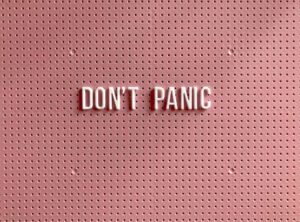Crippling anxiety is not a clinical term or an official diagnosis. Rather, it is a common expression used to describe an intense, all-consuming anxiety that significantly hinders your ability to function or interact with the world. It can make even handling simple tasks a constant struggle, affect your relationships and performance at work, and cause you to confine yourself to a limited, narrow life.
Our anxiety does not come from thinking about the future, but from wanting to control it. – Kahlil Gibran
Symptoms of Crippling Anxiety
Mental symptoms Crippling anxiety often manifests as intense, overwhelming, irrational worry about stuff that hasn’t happened yet and may never happen. Your imagination puts a negative spin on the future that assaults your peace of mind and leads you to overthink things, create negative mental scenarios, and second-guess decisions to the point of paralysis. It can be mentally debilitating, cause you to be hypervigilant, and make it hard for you to focus on anything else.
Emotional/behavioral symptoms Crippling anxiety tends to create a tangle of intense emotions that can be overwhelming. You may feel irritable, isolated, out of control, agitated, lose interest in activities you once enjoyed, be consumed by overwhelming fear and a continuous sense of dread, and/or engage in compulsive behaviors such as excessive handwashing.
Physical symptoms Crippling anxiety takes a toll on your body as well as your mind and emotions and can be just as disruptive to it. Physical symptoms may include digestive issues, muscle tension, rapid heartbeat, chest pain, trembling, shortness of breath, trouble sleeping, sweating, panic attacks, lightheadedness, and/or a frequent need to urinate.
Importance Of Identifying Triggers
Crippling anxiety can manifest differently in different people, and be influenced by genetics, environmental factors, and personal experiences. Understanding these influences can help shed light on the root causes of your anxiety, help you recognize and address triggers, develop effective coping strategies specific to your needs, and learn how to make your way through challenging times in healthy ways.
Common triggers of crippling anxiety can include stressful events such as trauma, sudden life changes, financial concerns, watching the news, the loss of a loved one, or an upsetting health issue. They also may include environmental factors such as crowded places, medical procedures, heights, flying, social situations, speaking in front of people, or certain bugs or animals.
Knowing what your triggers are can help you prepare for them in advance or, if possible, find ways to avoid them.
Managing Crippling Anxiety
The following are some recommended lifestyle changes and coping techniques that can decrease the intensity of your symptoms and enable you to regain control.
Practice deep breathing
 Focusing on your breath helps break the cycle of anxious thoughts by redirecting your focus from feelings of fear or panic to the physical sensations of breathing. Deep, controlled, abdominal breathing can calm your nervous system and provide quick relief during an episode of intense anxiety.
Focusing on your breath helps break the cycle of anxious thoughts by redirecting your focus from feelings of fear or panic to the physical sensations of breathing. Deep, controlled, abdominal breathing can calm your nervous system and provide quick relief during an episode of intense anxiety.
There are several techniques to choose from, such as box breathing, in which you inhale slowly to a count of four, hold your breath for a count of four, exhale slowly for a count of four, hold for a count of four, and repeat the cycle. Do this several times until you feel your body start to relax.
Use grounding techniques
Grounding techniques redirect your focus from your feelings of panic to physical sensations that connect you to the present moment. These can be as simple as running cold water over your wrists, putting an ice pack on the back of your neck, or touching objects around you and feeling their texture. You can also use guided imagery, visualization, or mindfulness practices.
An example of visualization is seeing yourself in a safe, relaxing place in as much vivid detail as possible, including smells and sounds.
Examples of mindfulness techniques include the 3-3-3 exercise, where you look for three things you can see, three things you can hear, and move three different parts of your body; and the 5-4-3-2-1 method, which engages all five senses by having you tune into your surroundings and find five things you can see, four things you can feel, three things you can hear, two things you can smell, and one thing you can taste.
Perform bilateral stimulation
Bilateral stimulation, such as tapping, engages both sides of your brain. The rhythmic action of alternately stimulating one side of it and then the other has a calming effect on your nervous system. To do it, place your left hand on your right shoulder, and your right hand on your left shoulder, and then slowly alternate tapping with each hand until you feel more grounded.
Lifestyle changes
Lifestyle changes such as better sleep routines; eating a well-balanced, nutritious diet; staying hydrated; avoiding caffeine and alcohol; and moving your body every day, can all help you feel calmer, and more in control, and enhance your overall feeling of well-being.
Exercise
Moving your body helps shift your focus and relieve physical tension in your body. Studies have shown that exercise changes brain chemistry by increasing the production of feel-good endorphins, which when released into your bloodstream, tend to have a mood-boosting, stress-relieving, anxiety-reducing effect.
Exercising consistently can also help you sleep better, become more resilient, increase your ability to concentrate, improve your self-esteem and sense of control, and enhance your overall outlook on life.
Take it to the Lord
Take your anxiety to the Lord in prayer and ask Him to help you. Write out Bible verses and promises and post them where you can see them throughout the day, such as your bathroom mirror or your refrigerator door. Memorize them and say them out loud.
Use them to reframe negative thought patterns and align them with the truths from God’s Word. For instance, when you feel paralyzed by anxiety and it whispers, “You can’t do this,” respond with “It is written, I can do all things through Christ who gives me strength.” (Philippians 4:13)
Scriptures About Anxiety
God never intended for us to worry about the challenges in our lives or try and handle them on our own. He wants us to bring our burdens and anxieties to Him and trust Him with them. He has also given us instructions in His Word to help us break free of the negative thought patterns that fuel our anxiety and become transformed by the renewing of our minds.
“Come to me, all you who are weary and burdened, and I will give you rest. Take my yoke upon you and learn from me, for I am gentle and humble in heart, and you will find rest for your souls. For my yoke is easy and my burden is light.” – Matthew 11:28-30, NIV
Cast your cares on the LORD and he will sustain you; he will never let the righteous be shaken. – Psalm 55:22, NIV
Cast all your anxiety on him because he cares for you. – 1 Peter 5:7, NIV
Do not be anxious about anything, but in every situation, by prayer and petition, with thanksgiving, present your requests to God. And the peace of God, which transcends all understanding, will guard your hearts and your minds in Christ Jesus. – Philippians 4:6-7, NIV
Do not conform to the pattern of this world, but be transformed by the renewing of your mind Then you will be able to test and approve what God’s will is – his good, pleasing and perfect will. – Romans 12:2, NIV
Finally, brothers and sisters, whatever is true, whatever is noble, whatever is right, whatever is pure, whatever is lovely, whatever is admirable – if anything is excellent or praiseworthy – think about such things. – Philippians 4:8, NIV
If you are struggling with crippling anxiety and feel you need more help than what this article could provide, please give us a call today. We would be happy to answer your questions and set up a risk-free appointment with one of the faith-based counselors at our location to help you manage the challenges you are facing.
Photo:
“Don’t Panic”, Courtesy of Tonik, Unsplash.com, CC0 License
-
Kate Motaung: Curator
Kate Motaung is the Senior Writer, Editor, and Content Manager for a multi-state company. She is the author of several books including Letters to Grief, 101 Prayers for Comfort in Difficult Times, and A Place to Land: A Story of Longing and Belonging...
DISCLAIMER: THIS ARTICLE DOES NOT PROVIDE MEDICAL ADVICE
Articles are intended for informational purposes only and do not constitute medical advice; the Content is not intended to be a substitute for professional medical advice, diagnosis, or treatment. All opinions expressed by authors and quoted sources are their own and do not necessarily reflect the opinions of the editors, publishers or editorial boards of Irvine Christian Counseling. This website does not recommend or endorse any specific tests, physicians, products, procedures, opinions, or other information that may be mentioned on the Site. Reliance on any information provided by this website is solely at your own risk.





